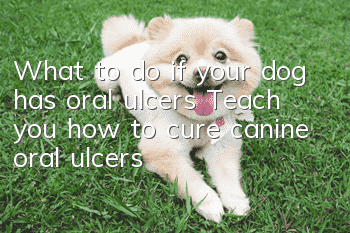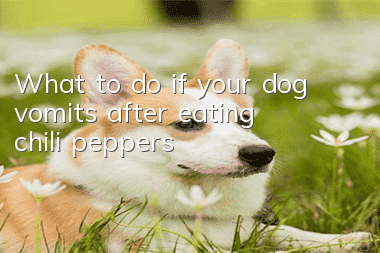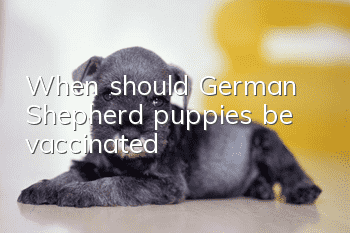What to do if your dog has oral ulcers? Teach you how to cure canine oral ulcers

Oral ulcers in dogs
Oral ulcers in dogs are a common ulcerative damage condition that occurs in the oral mucosa. It is most common on the inside of the lips, tongue, tongue belly, buccal mucosa, vestibular groove, and soft palate. In other parts of the body, the mucosa in these parts lacks the cornified layer or is poorly keratinized. Tongue ulcers refer to oral ulcers that occur on the tongue and tongue belly. When oral ulcers occur, the pain is severe and the local burning pain is obvious. In severe cases, it can also affect diet and make you depressed. Traumatic ulcers are closely related to mechanical stimulation, chemical burns, or hot and cold stimulation, and their location and shape are consistent with mechanical stimulation factors. There is no history of recurrence, and the ulcer heals quickly after the irritation is removed, but if left to develop, there is the possibility of cancer.
Incidence of oral ulcers in dogs
The sick dog is a 9-year-old Chinese garden dog. The dog mainly complained that the dog had severe salivation and had been depressed for the past two days. Water would flow from the corners of the mouth when drinking water. In fact, He kept licking his left upper lip with his tongue and was inactive. He was unwilling to come into contact with other dogs when going out. He refused to eat dog food and was only willing to lick a small amount of milk powder. His drinking water was normal, so he was taken to our hospital for treatment.
The dog was examined and his temperature was 39 degrees. 2 degrees Celsius, breathing 34 times per minute, heart rate 105 beats/minute. The dog showed obvious resistance to oral palpation, was unwilling to touch, and showed obvious pain. A preliminary oral examination found that the dog's right tooth was missing, the left tooth was stone yellow, the upper gums were swollen, the mouth ulcer was severe, and the mucous membrane showed signs of suppuration.
Diagnosis of Dog Oral Ulcer Cases
It was initially suspected to be gingivitis and oral ulcers caused by dental calculus. Because the dog had a long course of disease and was obviously resistant to oral exploration, it was decided to undergo anti-inflammatory treatment first to reduce the inflammatory reaction, and then conduct further oral examination after the swelling subsided.The treatment process of oral ulcers in dogs
Intramuscular injection of ampicillin sodium according to the dog's weight, twice a day, 0.5 grams each time. At the same time, the oral cavity was rinsed and disinfected with boric acid solution. During the rinse, the dog reacted strongly and felt obvious pain, but no bleeding was seen. Apply iodine glycerin to the ulcerated area. Take vitamin B2 and vitamin C orally, 10 mg once a day. The pet owner was required to feed liquid food. That night, the dog licked about 35ml of goat milk powder and took the initiative to eat half an egg white.On the third day of treatment, the dog's appetite improved. He ate a small amount of egg yolk and no bleeding from the mouth was seen. Continue intramuscular injection of half a gram of ampicillin sodium twice a day. When the dog is cleaned with boric acid solution, the reaction is reduced and the resistance is significantly reduced. Apply iodine glycerin. Orally take vitamin B2 and vitamin C, 10 mg once a day. In the evening, the dog ate a small amount of food.
On the fourth day of treatment, the dog licked about 50 ml of milk powder in the morning and ate more than half an egg, with almost no symptoms of salivation. His spirit has improved significantly compared with the previous two days. He actively interacts with his owner and can lick his hands with his tongue. No other discomfort is seen. Continue to intramuscularly inject ampicillin sodium, half a gram once in the morning and afternoon. When the left upper lip was opened, it was found that the redness and swelling of the gums had subsided significantly. The dog was almostNo more resistance, the pain was significantly reduced. Oral exploration revealed a 2 mm fish bone embedded in the gum behind the upper canine tooth on the left side. After slowly taking it out, it was found that there were obvious old wounds on the gums. Continue to rinse with two percent boric acid solution and apply iodine glycerin. Take vitamin B2 and vitamin C orally, 10 mg once a day. In the evening, the pet owner soaked a small amount of dog food with egg yolks, and the dog ate it all and returned to normal appetite.On the fifth day of treatment, the dog ate 50 ml of goat milk powder and a small amount of soaked dog food in the morning, and continued to intramuscularly inject ampicillin sodium, half a gram once in the morning and afternoon. Continue to rinse the mouth with 2% boric acid solution. The dog has slight resistance to the most untouched objects, so apply iodine glycerin. Take vitamin B2 and vitamin C orally. 10mg once a day. After treatment, I went home and observed that there was no more leakage when drinking water. In the evening, I fed him minced chicken breast mixed with dog food. My eating speed increased compared to the previous few days, and I ate it all.
On the 8th day of treatment, the pet owner was fed normal dog food every morning. His appetite basically recovered and his mental state was normal. The oral examination revealed that the redness and swelling of the gums had disappeared, the mucous membrane had recovered well, and anti-inflammatory drugs were discontinued. Continue taking both vitamins by mouth for three days.
On the tenth day, he came to the hospital for review and found that the dog had recovered and stopped taking medication.Preventing Oral Ulcer Disease in Dogs
This dog is an elderly dog, and its physical skills have declined in all aspects, its body resistance is low, and the owner feeds fish with thorns, which are the causes of the disease. Reducing the intake of hard objects such as bones, fish, fruit shells, etc. can prevent the occurrence of this disease. If conditions permit, pay attention to the intake of various vitamins and trace elements to improve the dog’s resistance. Pay attention to the dog’s oral hygiene and discover the oral hygiene of the dog. Lesions must be treated promptly.Discussion and Summary
Today’s pet owners regard their dogs as part of their own family, and do not take into account the dog’s own characteristics in the dog’s diet and give human food, so the dog often eats Some foods are dangerous to it. As a veterinarian, in addition to observing the condition of the animal, you should also conduct careful consultation to find the correct cause of the disease.In the treatment of traumatic oral ulcers, we must first find out the cause, determine the location of the wound, the type and properties of the foreign body, and follow the principles of specimen treatment and treatment to remove the foreign body and reduce inflammation. Pain, obvious damage to the mucosa. Elderly dogs should take vitamin supplements due to their low resistance to ensure full absorption of vitamins. During the feeding process, you should pay attention to drinking as much water as possible after the onset of illness to ensure protein intake. If the disease lasts for a long time, we recommend continuing the infusion treatment to ensure the dog’s normal energy supply.
- Dog snorts in the nose
- Wipe dog tear stains with light salt water
- Will it be okay if a dog eats shrimp shells?
- Will a dog die immediately if he eats ibuprofen?
- How many days can a dog usually live with internal bleeding?
- What can gray teddy eat to make their coat color more beautiful?
- Signs 5 hours before Teddy gives birth
- Why Teddy is voted the most annoying dog
- Bichon Frize hates owner's behavior
- Can huskies eat small persimmons?



